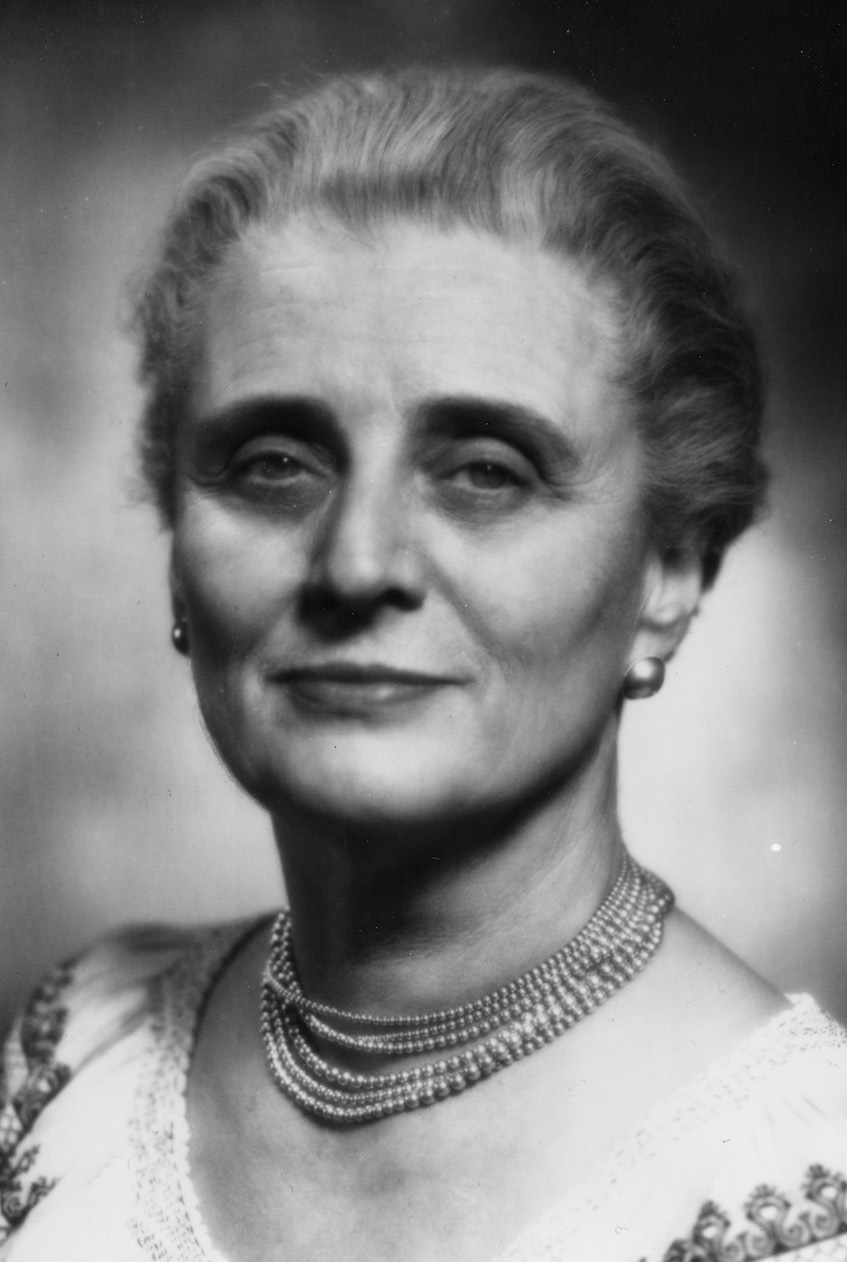“Sex involves something you are, not just something you do,” Dr. Mary Steichen Calderone told the Albuquerque Journal in 1967. The frank, pithy former medical director of Planned Parenthood and founder of the Sexuality Information and Education Council of the US (SIECUS) was known to speak in maxims. In doing so the forgotten trailblazer of sex education shaped the way we think about sex and sexuality today, demanding we consider “healthy sexuality” a “birthright” and becoming a vital “voice of reason” at a time when attitudes towards sex were rooted in fear and repression—but were, critically, rapidly changing.
Calderone lived through almost the entire 20th century, watching as movements in birth control, feminism, and sex education overlapped and shifted. Born in 1904 to an upper-class, bohemian family, Calderone spent her first ten years in Paris as her parents’ marriage frayed: Although her father was a prominent photographer who was friends with Picasso and Matisse—when Mary was six, a famous story goes, she instructed the Romanian sculptor Constantin Brancusi to give his birds more uplifted heads, and he did it—her mother was steeped in prudish Victorian values; she did things like make the young Mary wear metal “mittens” to bed to prevent her from masturbating, a policy that Calderone later credited as an influence on her career as a sexual liberator. When World War I broke out, the family moved to the United States, where Calderone’s mother was from; the couple separated, and Mary chose to stay with her father in New York, where she attended private school. In 1921—five years after Margaret Sanger founded Planned Parenthood—she started at Vassar, majoring in chemistry.
Videos by VICE
Read more: Letters from Women Pleading for Abortion, Sent in 1917, Mirror Emails Sent Today
It was here that Calderone began to run into problems, because instead of furthering her studies in chemistry, she wanted to become an actress. According to Jeffrey Moran, the author of Teaching Sex: The Shaping of Adolescence in the 20th Century and a professor of history at the University of Kansas, Calderone might have just considered acting “because she was really beautiful, but it turns out that’s not really sufficient to get you an acting career.” She married another actor and had two children. As Calderone would later put it, she gave up this dream shortly after, when she realized she “couldn’t be as good as Katherine Cornell—that is, tops.”
What followed was, in Moran’s words, a “period of personal turbulence”: She and her husband got divorced (a product, she later said, of “sexual repression“), and to make ends meet Calderone eventually took a job selling toasters at a department store, where she “loved the toasters but… disliked the people.” She eventually rekindled her chemistry degree and began taking pre-med courses at Columbia at the urging of her Freudian psychoanalyst. But while there, signs emerged that she would struggle to follow the path of a traditional physician; a professor told her, “‘It does seem to me that you’re not quite at home with the lipids.” Then, her 8-year-old daughter died of pneumonia as she was about to take her exams. Though Calderone sunk into a depression, she nevertheless started medical school in 1939 and went on to get her master’s in public health, which led her to her second husband, Dr. Frank Calderone, who would go on to work for the World Health Organization and the UN.

Mary Steichen Calderone. Photo via Wikimedia Commons
Here, too, she had difficulties, working part-time as a school physician and feeling frustrated that people ignored her career as they celebrated her husband’s. It was only after he retired that she rose to prominence as a key voice in public health: In 1953, at age 49, she became the medical director of Planned Parenthood, another part-time job she took because, as she said, she had “no established practice, nothing to lose, and no qualified male physician would have taken it.”
Despite these apparently humble terms, it was a pivotal time to enter the organization, which had recently begun a sweeping campaign to improve its education and research programs, and in 1960, the contraceptive pill finally became widely available. In 1964, Calderone overturned the American Medical Association policy that prevented physicians from informing patients about birth control. As the fight to provide reproductive health services intensified, Calderone began focusing on something else: Americans’ desperate need for sex education.
“I think what really spurred her interest was hearing from ordinary Americans,” Moran says. “In her position at Planned Parenthood, she would get tons and tons of letters from bewildered young people manifesting all different degrees of sexual knowledge and sexual ignorance.” It was the ignorance that made her feel like she needed to get involved, and in 1964, Calderone left Planned Parenthood to co-found the Sexuality Information and Education Council of the US (SIECUS).
Its mission would consume her work for the rest of her life. At a time when the attitude towards sex education was what Moran calls “schizophrenic,” Calderone’s mission was refreshingly direct. Although a movement towards formal sex education began in the early 20th century, it was fairly “timid,” in Moran’s words, mainly focused on abstinence, adjustment to society, and how to be a “good, white, middle-class family member.” Thus, the purpose of SIECUS was both lofty and completely sensible:
To establish man’s sexuality as a health entity: to identify the special characteristics that distinguish it from, yet relate it to, human reproduction; to dignify it by openness of approach, study, and scientific research designed to lead towards its understanding and its freedom from exploitation; to give leadership to professionals and to society, to the end that human beings may be aided toward responsible use of the sexual faculty and towards assimilation of sex into their individual life patterns as a creative and re-creative force.
“She was pretty brave to be involved in this from the very beginning,” Moran says, noting that distributing pamphlets with sexual health information could get you prosecuted for obscenity up until the 1970s and 80s. Though she wasn’t exactly a “revolutionary,” Calderone quickly gained a reputation as the “world’s busiest lecturer on sex education.”
Though she might have resented the title: She wanted to bring parents and children into a free-form dialogue, rather than preaching at them. “She wanted sex ed to be a discussion, not just about the plumbing—which is sometimes what it had been in other sex ed programs—and not just about how to plan your wedding—which is also sometimes what other approaches had done,” Moran says. “She wanted it to be an integration of the physical aspects of sexuality (without flinching) with the moral aspects of sexuality, how it’s integrated into social life.” Described by People magazine in 1980 as “the aristocratic woman with the Wedgwood blue eyes, majestic manner and lyrical voice,” Calderone bolstered her message with quotable missives and a straightforward approach, and her sex-positive stances sound ripped from today’s more progressive sex education materials: “Sex is not just a series of genital acts“; “parents reflect our sexophobic society”; “the art of friendship between males in this country is seriously impeded by the almost pathological fear of homosexuality“; “the facts are that pornography does not produce crime. Lack of it may.” She was known to ask her classes, “What is a four-letter word that ends with a k and means sexual intercourse?” After a moment of confused giggling, she would reveal the answer: “It’s talk.”
She was pretty brave to be involved in this from the very beginning.
Young audiences appreciated Calderone’s candor, but these qualities also made her a target for conservative groups like the Christian Crusade, the John Birch Society, and the Moral Majority. (Comparisons to Cecile Richards—the bold, mini-skirt-wearing president of Planned Parenthood who frequently addresses ridiculous criticism from the GOP in appropriately strong terms—are not off-base.) In 1969, right-wing groups spent an estimated $40 million on a vicious smear campaign to ruin the “moral degenerate” and “aging sexual libertine” (who they also accused of being a communist). It didn’t help that SIECUS’s most prominent defender was often Playboy. Still, Calderone was undeterred. In a letter to the editor published in the New York Times in 1974 (the year she turned 70), Calderone swiftly disabused a critic named E. Rouault of her apparent misconceptions about sexual education. “I suggest that E. Rouault take the trouble to read ‘Man and Woman, Boy and Girl,’ by Money and Eerhardt…” Calderone writes. “If she can understand even half of it, I am willing to guarantee that never again will she be tempted to sound off in areas with which she is unfamiliar… Today, 95 percent of the medical schools of the United States include course work in human sexuality, and their medical students, as well as thousands of other professionals now trained, would be the first to decry and at the same time pity E. Rouault’s lack of factual knowledge.”
For More Stories Like This, Sign Up for Our Newsletter
The developments Calderone cites were largely due to her own efforts, but the conservative opposition eventually led Calderone to step down from the SIECUS executive director position, though not entirely willingly. (She stayed on in leadership roles with the organization until 1982.) “Calderone had become such a lightning rod that SIECUS members wanted to ease her out of the organization,” Moran said. “A lot of the opposition came to focus on her, and she was a polarizing figure who wouldn’t back down. She recognized that she had perhaps become a liability.”
Calderone was not without of-their-time blind spots. “She was still concerned that young people, especially young women, needed to hold off on getting involved in sex until they were older,” says Moran, and she also thought it was best to limit homosexuality, though she promoted tolerance above all else. Nevertheless, her determination to deepen and improve our understanding of sexuality is a helpful reminder of the kind of qualities we need in similar fights today. When a reporter asked her if the public’s willingness to discuss sex publicly had gone too far, she replied, “Truth can never go too far.”
More
From VICE
-

Photo: Eetum / Getty Images -

Photo: Lajst / Getty Images -

Photo: The Good Brigade / Getty Images -

Photo: kelly bowden / Getty Images
